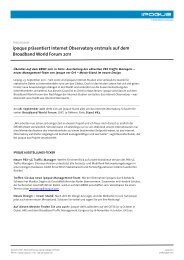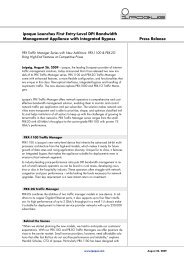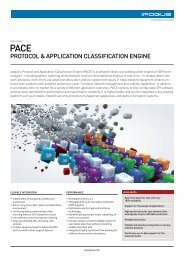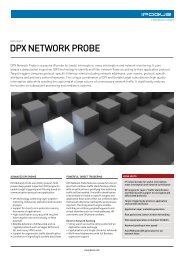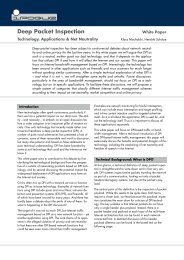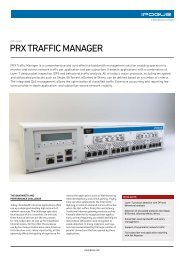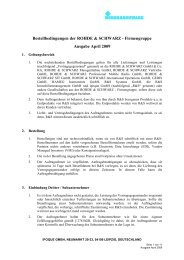Copyright Protection in the Internet - NeoOffice Writer - Ipoque
Copyright Protection in the Internet - NeoOffice Writer - Ipoque
Copyright Protection in the Internet - NeoOffice Writer - Ipoque
Create successful ePaper yourself
Turn your PDF publications into a flip-book with our unique Google optimized e-Paper software.
<strong>Copyright</strong> <strong>Protection</strong> <strong>in</strong> <strong>the</strong> <strong>Internet</strong> White Paper<br />
Approach<br />
Dur<strong>in</strong>g <strong>the</strong> last years, file shar<strong>in</strong>g of copyright-protected material, particularly <strong>in</strong> peerto-peer<br />
(P2P) networks, has been a serious threat to <strong>the</strong> established bus<strong>in</strong>ess models of<br />
<strong>the</strong> content <strong>in</strong>dustry. There have been numerous discussions about possible countermeasures,<br />
some of which have already been implemented. This white paper aims to<br />
provide an as objective as possible assessment of <strong>the</strong> countermeasures for P2P from<br />
<strong>the</strong> perspective of a network device vendor with particular experience with <strong>Internet</strong><br />
traffic management solutions.<br />
Music, movie and software companies as well as legacy<br />
publish<strong>in</strong>g houses claim billion-Euro revenue losses<br />
that have driven <strong>the</strong>m to job cuts. The widespread illegitimate<br />
shar<strong>in</strong>g of copyright-protected material thus has<br />
a negative economical impact both on a national and<br />
<strong>in</strong>ternational scale. There are many, often contradictory<br />
statements about feasibility and effectiveness of countermeasures<br />
for P2P file shar<strong>in</strong>g. Judgments are often driven<br />
by <strong>the</strong> <strong>in</strong>terests of different groups, such as <strong>in</strong>dustry<br />
lobbyist and privacy activists, and <strong>the</strong>ir recommendations<br />
differ widely.<br />
In this white paper <strong>the</strong> focus lies on technical solutions.<br />
The countermeasures can be classified <strong>in</strong>to three categories:<br />
1. Prevention of file transfers at application level, irrespective<br />
of content of s<strong>in</strong>gle files<br />
2. Detection of copyrighted and non-copyrighted material,<br />
prevention of file transfers at s<strong>in</strong>gle file level or prosecution<br />
of <strong>in</strong>fr<strong>in</strong>gers<br />
3. Non-technical approaches<br />
While some proposed measures are simply unfeasible,<br />
o<strong>the</strong>rs could be implemented both from a technical and<br />
commercial perspective. Some of <strong>the</strong> measures can be<br />
comb<strong>in</strong>ed. However, we will look at each of <strong>the</strong>m <strong>in</strong>dividually<br />
and subject <strong>the</strong>m to a reality check, that immediately<br />
rules out some approaches. Non-technical (political,<br />
legal and economic) solutions are regarded <strong>in</strong> <strong>the</strong><br />
third part but not evaluated. The two feasible measures<br />
will be evaluated, based on <strong>the</strong> follow<strong>in</strong>g criteria:<br />
Authors: Klaus Mochalski, Hendrik Schulze, Frank Stummer<br />
Technical feasibility:<br />
Can <strong>the</strong> measure be implemented technically? What <strong>in</strong>frastructure<br />
is necessary? Is it already be<strong>in</strong>g used or is it<br />
still under development?<br />
Effectiveness:<br />
How effective and comprehensive is <strong>the</strong> measure?<br />
Costs and time of implementation:<br />
How expensive is <strong>the</strong> first <strong>in</strong>stallation? Who would pay<br />
or how can costs be shared? How long would <strong>the</strong> implementation<br />
take?<br />
Operation and ma<strong>in</strong>tenance costs:<br />
What ma<strong>in</strong>tenance does <strong>the</strong> measure require? What<br />
costs does it <strong>in</strong>volve and who bears <strong>the</strong>m?<br />
Impact on <strong>Internet</strong> users:<br />
Is <strong>the</strong>re a privacy or data protection impact? Will it limit<br />
service availability?<br />
Impact on <strong>Internet</strong> service providers:<br />
What <strong>in</strong>frastructure changes are necessary? Does <strong>the</strong><br />
measure <strong>in</strong>volve additional workload when offer<strong>in</strong>g <strong>Internet</strong><br />
service to customers? Do bus<strong>in</strong>ess models have to<br />
be changed?<br />
Impact on content providers:<br />
Which <strong>in</strong>put is necessary from content providers? Is it<br />
possible to protect all titles? Do bus<strong>in</strong>ess models have to<br />
be changed?<br />
Impact for governments and society:<br />
Is a change <strong>in</strong> legislation necessary? Does political consensus<br />
appear to be achievable? Would <strong>the</strong> measure be<br />
politically unpopular? How severe would lobby groups<br />
react?<br />
www.ipoque.com © 2009 ipoque
Assumptions<br />
Many transfer methods can be used to share legal and<br />
illegal content. An optimal countermeasure should be<br />
able to solve <strong>the</strong> problem of copyright <strong>in</strong>fr<strong>in</strong>gements effectively,<br />
efficiently and as comprehensive as possible.<br />
Although a 100% solution is generally impossible, most<br />
of <strong>the</strong> current methods for illegitimate content shar<strong>in</strong>g<br />
(e.g. P2P networks, file host<strong>in</strong>g services, stream<strong>in</strong>g services)<br />
should be covered. The legitimate use of all <strong>the</strong>se<br />
services has to be taken <strong>in</strong>to account.<br />
O<strong>the</strong>r distribution systems used for more serious crim<strong>in</strong>al<br />
activities (e.g. pedophilia, terrorism, organized crime),<br />
such as closed private networks or <strong>the</strong> exchange of storage<br />
media via e-mail, are difficult to control with <strong>the</strong><br />
proposed measures. They require crim<strong>in</strong>al <strong>in</strong>vestigation<br />
methods, which means a higher effort but also a higher<br />
effectiveness.<br />
Nearly all measures <strong>in</strong>cur a more or less serious <strong>in</strong>terference<br />
with <strong>Internet</strong> traffic and thus a violation of net neutrality.<br />
This paper will not discuss this issue because<br />
<strong>the</strong>re are no clear and generally agreed def<strong>in</strong>itions of<br />
net neutrality. While this discussion is important, it<br />
would go beyond <strong>the</strong> scope of this paper.<br />
P2P file shar<strong>in</strong>g is produc<strong>in</strong>g more traffic <strong>in</strong> <strong>the</strong> <strong>Internet</strong> than all<br />
o<strong>the</strong>r applications comb<strong>in</strong>ed as shown <strong>in</strong> this figure taken from<br />
ipoque's <strong>Internet</strong> Study 2007.<br />
Protocol distribution <strong>in</strong> Germany<br />
2<br />
1 Host- and Application-Level Traffic<br />
Management<br />
Methods to prevent undesired file transfers on host and<br />
application level require manipulation of <strong>Internet</strong> traffic,<br />
thus ei<strong>the</strong>r extension of exist<strong>in</strong>g or <strong>in</strong>stallation of new<br />
devices.<br />
1.1 Block<strong>in</strong>g of IP Addresses/DNS Names<br />
Access to <strong>in</strong>dividual <strong>Internet</strong> hosts is blocked based on<br />
IP address or host name. On one side, this allows to<br />
block access to central servers that offer copyright-protected<br />
material, such as file host<strong>in</strong>g services, for <strong>in</strong>stance.<br />
On <strong>the</strong> o<strong>the</strong>r side, also <strong>in</strong>dividual subscribers<br />
can be blocked temporarily or permanently, if <strong>the</strong>y are<br />
known <strong>in</strong>fr<strong>in</strong>gers. In both cases, block<strong>in</strong>g needs to be<br />
implemented close to <strong>the</strong> network edge, for <strong>in</strong>stance at<br />
<strong>the</strong> DSLAM (DSL term<strong>in</strong>ation) or CMTS (cable term<strong>in</strong>ation)<br />
level.<br />
Reality Check<br />
Dynamic IP addresses and network address translation<br />
(NAT) restrict technical feasibility. The implementation is<br />
possible at ISP level, where dynamic address mapp<strong>in</strong>g<br />
<strong>in</strong>formation is - at least <strong>in</strong> <strong>the</strong>ory - available.<br />
Conclusion<br />
It is <strong>the</strong>oretically possible but <strong>in</strong>fr<strong>in</strong>gers would<br />
have to be detected first (See category 2 for such<br />
measures). Block<strong>in</strong>g of IP addresses could be an<br />
additional measure <strong>in</strong> a comb<strong>in</strong>ation of different<br />
measures, but is not <strong>the</strong> solvation of <strong>the</strong> problem<br />
itself.<br />
1.2 Block<strong>in</strong>g of URLs<br />
Access to URLs hosted by <strong>in</strong>fr<strong>in</strong>g<strong>in</strong>g Web servers can be<br />
blocked. This requires URL filters with a database of<br />
URLs that are to be blocked.<br />
Reality Check<br />
URL filters are widely available. Centrally hosted services<br />
such as Piratebay and even BitTorrent trackers<br />
could be blocked. An up-to-date list of URLs is a necessary<br />
prerequisite to make this measure effective. Unfortunately,<br />
it is nearly impossible to keep <strong>the</strong> URL<br />
database current. Affected sites could rapidly change<br />
URLs and propagate <strong>the</strong>se changes. Ultimately, this<br />
would result <strong>in</strong> a never-end<strong>in</strong>g cat and mouse game.
P2P networks with no central servers are totally off limits<br />
for this approach.<br />
Conclusion<br />
Block<strong>in</strong>g of URLs only makes sense as a<br />
complementary measure <strong>in</strong> specific cases such as<br />
web sites with crim<strong>in</strong>al content.<br />
1.3 Block<strong>in</strong>g of TCP and UDP Ports<br />
All ports used by <strong>in</strong>fr<strong>in</strong>g<strong>in</strong>g applications will be<br />
blocked.<br />
Reality Check<br />
Port block<strong>in</strong>g systems are widely available, but many<br />
applications do not adhere to standards with regard to<br />
port usage anymore to avoid be<strong>in</strong>g detected by <strong>the</strong>se<br />
systems.<br />
Conclusion<br />
This is an old idea that does not work at all<br />
anymore.<br />
1.4 Black- and Whitelist<strong>in</strong>g of Protocols and<br />
Applications<br />
Block (blacklist<strong>in</strong>g) and allow (whitelist<strong>in</strong>g) specific applications<br />
based on layer-7 classification. Candidates<br />
for <strong>the</strong> blacklist would be applications that are mostly<br />
used for illegal content distribution who are try<strong>in</strong>g to<br />
avoid monitor<strong>in</strong>g by us<strong>in</strong>g encryption. Candidates for<br />
<strong>the</strong> whitelist would be applications or services that cannot<br />
be used for illegal content distribution or are monitored<br />
by o<strong>the</strong>r means.<br />
Reality Check<br />
Black- and whitelist<strong>in</strong>g is technically feasible with current<br />
deep packet <strong>in</strong>spection (DPI) and behavioral analysis<br />
(BA) technology, which allows <strong>the</strong> reliable classification<br />
of protocols even if <strong>the</strong>y are us<strong>in</strong>g encryption or obfuscation.<br />
However, blacklist<strong>in</strong>g and – even more so –<br />
whitelist<strong>in</strong>g would seriously impede <strong>in</strong>novation <strong>in</strong> <strong>the</strong> <strong>Internet</strong>,<br />
because usage of new protocols would be<br />
severely restricted. P2P networks are a good example.<br />
While <strong>the</strong> overwhelm<strong>in</strong>g proportion of exchanged content<br />
violates copyrights, <strong>the</strong> networks <strong>the</strong>mselves are im-<br />
3<br />
portant new technologies. Not only copyright <strong>in</strong>fr<strong>in</strong>gers<br />
use P2P but also scientists share <strong>the</strong>ir research data this<br />
way.<br />
For a really comprehensive approach, a large-scale coord<strong>in</strong>ation<br />
at least at national, better transnational, level<br />
would be required. All ISPs would have to cooperate.<br />
Politically, this is hardly imag<strong>in</strong>able <strong>in</strong> most nations, not<br />
only <strong>in</strong> light of <strong>the</strong> current net neutrality debate. It would<br />
mean a return to <strong>the</strong> very roots of <strong>the</strong> <strong>Internet</strong>, only with<br />
strictly enforced standards. Ultimately, this measure<br />
would br<strong>in</strong>g <strong>the</strong> <strong>Internet</strong> to a gr<strong>in</strong>d<strong>in</strong>g halt.<br />
An example is ipoque’s BitTorrent tracker whitelist<strong>in</strong>g,<br />
that allows access to guaranteed legal BitTorrent content,<br />
while block<strong>in</strong>g access to all o<strong>the</strong>r P2P content. This<br />
approach works because nearly all legal P2P content is<br />
distributed over BitTorrent us<strong>in</strong>g dedicated and controlled<br />
BitTorrent trackers. Operators can deploy such<br />
systems to limit access to and from <strong>the</strong>ir networks to improve<br />
security and prevent illegal file shar<strong>in</strong>g activities.<br />
This can be important because, depend<strong>in</strong>g on national<br />
jurisdiction, network operators may be liable to <strong>the</strong>ir<br />
users’ activities or are at least required to cooperate<br />
with legal authorities and private <strong>in</strong>fr<strong>in</strong>gement monitor<strong>in</strong>g<br />
firms.<br />
Conclusion<br />
Black- and whitelist<strong>in</strong>g of applications cannot be<br />
deployed throughout <strong>the</strong> <strong>Internet</strong>. However, it is a<br />
good option for <strong>in</strong>dividual network operators,<br />
such as companies or universities, to control <strong>the</strong>ir<br />
network usage. Traffic management systems with<br />
both whitelist<strong>in</strong>g and blacklist<strong>in</strong>g for various<br />
applications and even content-awareness are<br />
available on <strong>the</strong> market.<br />
1.5 Injection of Counterfeits<br />
In P2P networks, each user also is a content provider.<br />
This makes it easy to <strong>in</strong>ject counterfeited copies of files<br />
<strong>in</strong>to <strong>the</strong> network. Poor hash<strong>in</strong>g algorithms <strong>in</strong> <strong>the</strong> eDonkey<br />
P2P network, for a long time had allowed to offer<br />
same-size files with different content but equal hash values.<br />
Today, this is no longer possible due to new hash<strong>in</strong>g<br />
algorithms.<br />
Reality Check<br />
Current file shar<strong>in</strong>g networks use strong protection<br />
mechanisms aga<strong>in</strong>st <strong>the</strong> <strong>in</strong>jection of counterfeited
copies. It was common practice to <strong>in</strong>ject fake files (i.e.<br />
files with mislead<strong>in</strong>g names) <strong>in</strong>to file shar<strong>in</strong>g networks –<br />
and to a lesser degree still is today. This has significantly<br />
decreased <strong>the</strong> content quality particularly <strong>in</strong> <strong>the</strong> eDonkey<br />
network. As <strong>the</strong> ma<strong>in</strong> effect, <strong>the</strong>se measures have<br />
driven file sharers to <strong>the</strong> BitTorrent network, that is nearly<br />
immune aga<strong>in</strong>st <strong>in</strong>jection of fake files, ma<strong>in</strong>ly because<br />
content distribution is organized through Webbased<br />
torrent directories such as <strong>the</strong>piratebay.org.<br />
Conclusion<br />
The <strong>in</strong>jection of counterfeits is no effective<br />
countermeasure anymore.<br />
1.6 Exploitation of Vulnerabilities <strong>in</strong> File<br />
Shar<strong>in</strong>g Software<br />
Attacks on file shar<strong>in</strong>g networks us<strong>in</strong>g implementation<br />
and protocol vulnerabilities to derail <strong>the</strong>ir proper function.<br />
Reality Check<br />
As for any computer system, attacks are possible, and<br />
<strong>the</strong>re are commercial providers offer<strong>in</strong>g this as a service.<br />
An attack on eDonkey, for <strong>in</strong>stance, may have <strong>the</strong><br />
effect that <strong>the</strong> downloaded file is larger than <strong>the</strong> orig<strong>in</strong>al,<br />
and <strong>the</strong> download never f<strong>in</strong>ishes. There are similar<br />
attacks for BitTorrent.<br />
Conclusion<br />
As this k<strong>in</strong>d of attack is based on vulnerabilities,<br />
<strong>the</strong> common risk with such measures is that <strong>the</strong><br />
vulnerabilities will be fixed. The short-lived<br />
effectiveness makes <strong>the</strong> measures expensive and<br />
only worthwhile for a limited number of highly<br />
valuable files (e.g. newly released movies and<br />
computer games, expensive software).<br />
2 File-Level Traffic Management<br />
The follow<strong>in</strong>g methods are able to detect a s<strong>in</strong>gle file<br />
and f<strong>in</strong>d copyright protected content <strong>in</strong> it. Once <strong>the</strong>y detect<br />
copyright protected content, <strong>the</strong>re are two possible<br />
actions: ei<strong>the</strong>r to prevent <strong>the</strong> file transfer directly; or to<br />
prosecute <strong>in</strong>fr<strong>in</strong>gers afterwards. In <strong>the</strong> first case, <strong>the</strong> exchanged<br />
file's hash value (or ano<strong>the</strong>r k<strong>in</strong>d of<br />
f<strong>in</strong>gerpr<strong>in</strong>t) is compared to a database or classification<br />
system. Based on <strong>the</strong> verdict, <strong>the</strong> file transfer is ei<strong>the</strong>r<br />
4<br />
blocked or allowed. Both blacklist<strong>in</strong>g and whitelist<strong>in</strong>g<br />
are possible to block or allow file transfers. In <strong>the</strong> second<br />
case, <strong>the</strong> file transfer is allowed, but recorded for<br />
later prosecution.<br />
2.1 F<strong>in</strong>gerpr<strong>in</strong>t<strong>in</strong>g<br />
F<strong>in</strong>gerpr<strong>in</strong>t<strong>in</strong>g is a method that uses parts of a file to<br />
generate a f<strong>in</strong>gerpr<strong>in</strong>t. A transferred file's f<strong>in</strong>gerpr<strong>in</strong>t<br />
can <strong>the</strong>n be compared to a database of reference files<br />
and classified with a high reliability.<br />
Reality Check<br />
Although f<strong>in</strong>gerpr<strong>in</strong>t<strong>in</strong>g is already used commercially,<br />
<strong>the</strong> technology is still under development. Certa<strong>in</strong> parts<br />
of it have been used for a long time, for <strong>in</strong>stance <strong>the</strong> detection<br />
of patterns <strong>in</strong> pictures. There are no <strong>in</strong>dependent<br />
benchmarks for its accuracy and reliability.<br />
The major advantage of f<strong>in</strong>gerpr<strong>in</strong>t<strong>in</strong>g over o<strong>the</strong>r technologies<br />
is that modified copies of an orig<strong>in</strong>al file are<br />
still detected as copies of it, <strong>in</strong>dependent of <strong>the</strong> modifications.<br />
Due to its computational complexity, f<strong>in</strong>gerpr<strong>in</strong>t<strong>in</strong>g<br />
does not work <strong>in</strong> real-time for high-speed networks.<br />
Also, even though ever more file and compression formats<br />
are supported, f<strong>in</strong>gerpr<strong>in</strong>t<strong>in</strong>g is bl<strong>in</strong>d to encrypted<br />
archive files (e.g. password-protected ZIP files), and<br />
<strong>the</strong>se are becom<strong>in</strong>g more and more popular. Largescale<br />
deployment of f<strong>in</strong>gerpr<strong>in</strong>t<strong>in</strong>g technology would<br />
push <strong>the</strong> popularity of all k<strong>in</strong>ds of encryption and render<br />
<strong>the</strong> whole technology useless as a countermeasure.<br />
Conclusion<br />
F<strong>in</strong>gerpr<strong>in</strong>t<strong>in</strong>g systems do not operate <strong>in</strong> real-time<br />
and cannot be deployed on a large scale. They<br />
do not work with encrypted communication or<br />
encrypted files. Still, f<strong>in</strong>gerpr<strong>in</strong>t<strong>in</strong>g can be useful<br />
for an offl<strong>in</strong>e search of particular files and <strong>the</strong><br />
<strong>in</strong>volved IP addresses <strong>in</strong> captured network traffic.<br />
In addition, its ability to correlate modified copies<br />
with <strong>the</strong> orig<strong>in</strong>al file can be used to build a more<br />
complete database of file hashes, which can <strong>the</strong>n<br />
be used with file hash-based measures as<br />
described below.<br />
2.2 File Hash-Based Identification and<br />
Blacklist<strong>in</strong>g<br />
Each file <strong>in</strong> file shar<strong>in</strong>g networks has a unique ID. In<br />
P2P networks, this is <strong>the</strong> file hash, and <strong>in</strong> file host<strong>in</strong>g<br />
systems, this is <strong>the</strong> URL. For each title, <strong>the</strong>re often exists<br />
a number of files with different hash values, e.g. modi-
fied copies or different file formats. This is caused by<br />
different users offer<strong>in</strong>g <strong>the</strong> same title. Consequently, <strong>the</strong><br />
number of file hashes is significantly higher than <strong>the</strong><br />
number of unique titles circulat<strong>in</strong>g <strong>in</strong> file shar<strong>in</strong>g networks.<br />
In practice, however, only a limited number of<br />
such copies are propagated throughout <strong>the</strong> P2P network.<br />
The common ratio between a title and its copies<br />
usually is about 1:3-6.<br />
Reality Check<br />
Traffic managers are capable to ma<strong>in</strong>ta<strong>in</strong> file hash<br />
databases with at least one million entries and to selectively<br />
block or allow <strong>in</strong>dividual file transfers. While both<br />
black- and whitelist<strong>in</strong>g are <strong>in</strong> <strong>the</strong>ory possible, only<br />
blacklist<strong>in</strong>g would be politically viable. Whitelist<strong>in</strong>g,<br />
i.e., <strong>the</strong> controlled admission of validated files only,<br />
would be a serious <strong>in</strong>fr<strong>in</strong>gement of freedom of speech<br />
mak<strong>in</strong>g it all but politically impossible.<br />
File hash-based measures do work effectively with unencrypted<br />
and public shar<strong>in</strong>g services. Encrypted communication<br />
and private file shar<strong>in</strong>g networks can only be<br />
controlled by crim<strong>in</strong>alistic methods <strong>in</strong>volv<strong>in</strong>g a high effort.<br />
However, <strong>the</strong> vast majority of copyright <strong>in</strong>fr<strong>in</strong>gements<br />
happen <strong>in</strong> open services, as <strong>the</strong> public availability<br />
is <strong>the</strong> key success factor for such services.<br />
Technical feasibility:<br />
This measure can be implemented us<strong>in</strong>g currently available<br />
traffic management systems based on deep packet<br />
<strong>in</strong>spection deployed at network access or peer<strong>in</strong>g<br />
po<strong>in</strong>ts. A central management system would control<br />
<strong>the</strong>ir operation and also ma<strong>in</strong>ta<strong>in</strong> <strong>the</strong> file hash or f<strong>in</strong>gerpr<strong>in</strong>t<br />
database for files to be detected and blocked.<br />
Effectiveness:<br />
This measure can be effective for a whole country or<br />
even larger regions, if all relevant access or peer<strong>in</strong>g<br />
po<strong>in</strong>ts are covered. Blacklists have to be cont<strong>in</strong>ually<br />
ma<strong>in</strong>ta<strong>in</strong>ed.<br />
Costs and time of implementation:<br />
An <strong>in</strong>stallation at peer<strong>in</strong>g po<strong>in</strong>ts would cost approximately<br />
1.50 Euros per network user, and an <strong>in</strong>stallation<br />
at <strong>the</strong> access po<strong>in</strong>ts about ten times this amount. Costs<br />
could be borne by <strong>the</strong> ISPs (who would also benefit<br />
from additional functionalities provided by <strong>the</strong> traffic<br />
management systems), or by <strong>the</strong> government and thus<br />
by <strong>the</strong> taxpayer. Implementation should be feasible <strong>in</strong><br />
less than one year.<br />
Operation and ma<strong>in</strong>tenance costs:<br />
In addition to <strong>the</strong> ma<strong>in</strong>tenance of <strong>the</strong> traffic management<br />
systems (e.g. firmware updates, hardware ma<strong>in</strong>te-<br />
5<br />
nance), regular distribution of file hash databases is<br />
necessary, for <strong>in</strong>stance every 48 hours. This database<br />
has to be ma<strong>in</strong>ta<strong>in</strong>ed at a central entity. Based on experience,<br />
a s<strong>in</strong>gle person is able to manually track 1,000<br />
titles. Assum<strong>in</strong>g that 10,000 English titles have to be<br />
monitored, 10 staff would be able to do <strong>the</strong> job. O<strong>the</strong>r<br />
language regions would require about 1-5 staff. The<br />
hash databases can be used <strong>in</strong>ternationally. One worldwide<br />
copyright agency could be operated by <strong>the</strong> content<br />
<strong>in</strong>dustry, for example. Annual costs would be less<br />
than 1 Euro per user.<br />
Impact on <strong>Internet</strong> users:<br />
There is no noticeable change for <strong>Internet</strong> users apart<br />
from copyright-protected files not be<strong>in</strong>g downloadable<br />
anymore. There are no privacy or data protection issues,<br />
as no subscriber IP addresses or any o<strong>the</strong>r personal<br />
details are be<strong>in</strong>g tracked.<br />
Impact on ISPs:<br />
ISPs have to deploy traffic management systems at a sufficient<br />
number of access or peer<strong>in</strong>g po<strong>in</strong>ts. The devices<br />
can be implemented with bypasses, which secure un<strong>in</strong>terrupted<br />
network connectivity. There is no change <strong>in</strong><br />
<strong>the</strong> services offered and bus<strong>in</strong>ess models <strong>in</strong> general.<br />
Impact on content providers:<br />
Content providers can – and have to – provide a list of<br />
titles <strong>the</strong>y want protected. Depend<strong>in</strong>g on <strong>the</strong> level of service<br />
provided through <strong>the</strong> discussed central agency,<br />
<strong>the</strong>y could ei<strong>the</strong>r provide <strong>the</strong> names of titles or a list of<br />
relevant hash values. Because <strong>the</strong> list of titles that can<br />
be monitored is f<strong>in</strong>ite, it needs to be cont<strong>in</strong>ually updated<br />
and cleaned from outdated entries. It should focus<br />
ma<strong>in</strong>ly on popular and current titles. One possible model<br />
would be that content providers pay a per-title fee to<br />
<strong>the</strong> monitor<strong>in</strong>g agency. Current bus<strong>in</strong>ess models could<br />
be effectively protected with this measure.<br />
Impact on governments and society:<br />
The implementation of a nationwide (or even <strong>in</strong>ternational)<br />
protection system requires sufficient and enforceable<br />
rules – ei<strong>the</strong>r through legal or <strong>in</strong>dustry regulations.<br />
The implementation of such a system is new territory for<br />
most countries and would certa<strong>in</strong>ly trigger fierce debates<br />
<strong>in</strong>volv<strong>in</strong>g <strong>the</strong> content <strong>in</strong>dustry, privacy and data<br />
protectionists, and consumer protection groups. In several<br />
countries <strong>the</strong>re are ongo<strong>in</strong>g discussions about this<br />
countermeasure.<br />
Conclusion<br />
Blacklist<strong>in</strong>g based on file hashes or o<strong>the</strong>r file IDs<br />
can provide a viable way to severely limit <strong>the</strong><br />
distribution of copyright-protected content.
2.3 Sign<strong>in</strong>g of Transmitted Content with a<br />
Legally B<strong>in</strong>d<strong>in</strong>g Digital Signature<br />
Each shared file needs to be digitally signed through<br />
personal certificates. With this signature, a person or legal<br />
entity shar<strong>in</strong>g a file certifies <strong>the</strong> ownership and consent<br />
for shar<strong>in</strong>g of <strong>the</strong> file. In case of misuse, <strong>the</strong> sharer<br />
can be easily prosecuted. All files without a valid signature<br />
would be blocked.<br />
Reality Check<br />
Different k<strong>in</strong>ds of sign<strong>in</strong>g technologies are available<br />
and <strong>in</strong> use for several applications. Due to <strong>the</strong> fact, that<br />
<strong>the</strong>y do not have a legal or central entity it is nearly impossible<br />
to enforce it for public file shar<strong>in</strong>g networks.<br />
Also, file host<strong>in</strong>g services can easily avoid a prosecution<br />
by mov<strong>in</strong>g to ano<strong>the</strong>r country.<br />
Conclusion<br />
A modification of file shar<strong>in</strong>g networks with sign<strong>in</strong>g<br />
techniques would very effectively solve <strong>the</strong><br />
problem. It is a good solution for several<br />
applications. But <strong>the</strong> implementation is not<br />
possible for widespread, public file shar<strong>in</strong>g<br />
networks or services.<br />
2.4 Watermark<strong>in</strong>g and Investigation of Seeders<br />
It is technically possible to armor each title with a digital<br />
watermark that would allow track<strong>in</strong>g its way through <strong>the</strong><br />
transmission cha<strong>in</strong>. The aim is to prosecute <strong>in</strong>fr<strong>in</strong>gers of<br />
copyrights. For example this method is already <strong>in</strong> use to<br />
determ<strong>in</strong>e <strong>the</strong> movie <strong>the</strong>ater where a movie was filmed<br />
off <strong>the</strong> screen and <strong>the</strong>n put <strong>in</strong>to a file shar<strong>in</strong>g network.<br />
Reality Check<br />
Conclusion<br />
It appears very likely that watermarks would be<br />
erased or destroyed if used on a large scale,<br />
result<strong>in</strong>g <strong>in</strong> yet ano<strong>the</strong>r cat and mouse game that<br />
cannot be won by <strong>the</strong> copyright owners.<br />
Mak<strong>in</strong>g watermark<strong>in</strong>g an effective measure requires full<br />
control over <strong>the</strong> entire production and distribution cha<strong>in</strong><br />
up to <strong>the</strong> screen and speaker. For CDs and DVDs, us<strong>in</strong>g<br />
current technology, this is not possible.<br />
6<br />
2.5 Monitor<strong>in</strong>g of <strong>Copyright</strong> Infr<strong>in</strong>gements<br />
Active and Passive Monitor<strong>in</strong>g<br />
In case of active monitor<strong>in</strong>g a monitor participates <strong>in</strong><br />
<strong>the</strong> P2P network as an active client and tries to download<br />
copyright-protected files. It can only f<strong>in</strong>d files it is<br />
explicitly look<strong>in</strong>g for. Files to be monitored are usually<br />
provided by <strong>the</strong> copyright owners. Only data of persons<br />
shar<strong>in</strong>g protected files are collected. No o<strong>the</strong>r traffic is<br />
monitored.<br />
Passive monitor<strong>in</strong>g <strong>in</strong>spects <strong>the</strong> complete <strong>Internet</strong> traffic,<br />
ignor<strong>in</strong>g all un<strong>in</strong>terest<strong>in</strong>g traffic and look<strong>in</strong>g only for exchanges<br />
of copyrighted titles. It causes severe privacy<br />
and data protection concerns as it has, potentially, access<br />
to all data, <strong>in</strong>clud<strong>in</strong>g e-mails, web traffic, etc. The<br />
two methods – active and passive monitor<strong>in</strong>g – are totally<br />
disparate technologies.<br />
Clear<strong>in</strong>g Instance<br />
Prerequisite for monitor<strong>in</strong>g of file shar<strong>in</strong>g networks is a<br />
central <strong>in</strong>stance that provides <strong>the</strong> mapp<strong>in</strong>g between <strong>the</strong><br />
IP address (along with <strong>the</strong> time of its record<strong>in</strong>g dur<strong>in</strong>g<br />
<strong>the</strong> monitor<strong>in</strong>g process) to <strong>the</strong> personal identity beh<strong>in</strong>d<br />
this address. The success of this measure depends on<br />
<strong>the</strong> clear<strong>in</strong>g <strong>in</strong>stance.<br />
In Germany, for <strong>in</strong>stance, <strong>the</strong> mapp<strong>in</strong>g could only be<br />
acquired through an official prosecution process. The<br />
flood of prosecutions has overwhelmed state attorneys.<br />
France, <strong>in</strong> contrast, has chosen to implement a much<br />
simpler and very promis<strong>in</strong>g process. The government<br />
has decided to implement a clear<strong>in</strong>g <strong>in</strong>stance, called<br />
HADOPI, and all parties are required to cooperate with<br />
it.<br />
Besides copyright violations <strong>in</strong> P2P networks, <strong>the</strong> clear<strong>in</strong>g<br />
<strong>in</strong>stance can also provide personal data <strong>in</strong> case of<br />
o<strong>the</strong>r <strong>in</strong>fr<strong>in</strong>gements, such as libels, agitation or similar.<br />
The mapp<strong>in</strong>g from IP addresses to personal data requires<br />
to store connection records over a certa<strong>in</strong> period<br />
of time, which is a controversy <strong>in</strong> some countries.<br />
Active Monitor<strong>in</strong>g<br />
Active monitor<strong>in</strong>g only works for P2P networks. Automated<br />
clients try to download copyright-protected files<br />
from <strong>the</strong>se networks, or also offer <strong>the</strong>m for download by<br />
o<strong>the</strong>rs. It is difficult for P2P users to detect <strong>the</strong>se clients<br />
because <strong>the</strong>y work just as ord<strong>in</strong>ary P2P programs.<br />
Clients can be modified so that <strong>the</strong>y only download, but<br />
do not upload, any files to avoid spread<strong>in</strong>g copyrighted<br />
material.
Active monitor<strong>in</strong>g can be conducted from virtually anywhere<br />
<strong>in</strong> <strong>the</strong> world, cover<strong>in</strong>g P2P networks <strong>in</strong>dependent<br />
of <strong>the</strong> <strong>in</strong>fr<strong>in</strong>ger's location. It also works just as good for<br />
encrypted P2P networks because <strong>the</strong> monitor participates<br />
as an ord<strong>in</strong>ary peer.<br />
Reality Check<br />
Active monitor<strong>in</strong>g has garnered a bad reputation because<br />
content providers have <strong>in</strong> <strong>the</strong> past often tried to<br />
crim<strong>in</strong>alize copyright <strong>in</strong>fr<strong>in</strong>gers and imposed ridiculous<br />
penalties as a deterrent. In addition, <strong>the</strong>re have been<br />
flawed lawsuits with verdicts about persons with no <strong>Internet</strong><br />
access. Careful <strong>in</strong>vestigation along with adequate<br />
penalties are necessary to improve <strong>the</strong> reputation of this<br />
measure, even more so as it bears <strong>the</strong> potential to solve<br />
<strong>the</strong> copyright problem <strong>in</strong> P2P networks.<br />
Technical feasibility:<br />
Different systems are available and have been <strong>in</strong> operation<br />
for some years. Different P2P networks, among<br />
<strong>the</strong>m <strong>the</strong> most popular services, are covered.<br />
Effectiveness:<br />
Such systems can detect <strong>in</strong>fr<strong>in</strong>gements for one or more<br />
countries – nationally and <strong>in</strong>ternationally. The location is<br />
not important. Especially automatic detection systems<br />
work highly efficiently and produce court-proof evidence<br />
data. This measure is very difficult to circumvent.<br />
Costs and time of implementation:<br />
A s<strong>in</strong>gle appliance could cover 2,000 to 10,000 titles<br />
and would cost 1 to 10 Euros per title. Costs could be<br />
covered by a fee from <strong>the</strong> <strong>in</strong>dustry, subsidies from <strong>the</strong><br />
government or <strong>the</strong> penalties from <strong>in</strong>fr<strong>in</strong>gers. A high organizational<br />
effort is necessary to implement <strong>the</strong> processes<br />
to prosecute <strong>in</strong>fr<strong>in</strong>gers. This could be done by<br />
<strong>the</strong> copyright holders, a lobby organization, or a state<br />
authority.<br />
Operation and ma<strong>in</strong>tenance costs:<br />
Depend<strong>in</strong>g on <strong>the</strong> requirements, detection of <strong>in</strong>fr<strong>in</strong>gers<br />
costs 1 to 10 Euros per title and year. A per-case fee<br />
would be possible, too. The cost of prosecution depends<br />
on <strong>the</strong> legal requirements and organizational set-up, but<br />
could be very efficiently done with automatic processes.<br />
The content providers or a lobby organization would<br />
have to feed <strong>the</strong> system by provid<strong>in</strong>g <strong>the</strong> titles or <strong>the</strong><br />
shared files for <strong>the</strong>se titles. Based on experience, a s<strong>in</strong>gle<br />
person is able to manually track 1,000 titles.<br />
Impact on <strong>Internet</strong> users:<br />
Only <strong>in</strong>fr<strong>in</strong>gers are detected and tracked, o<strong>the</strong>r users<br />
are not monitored by <strong>the</strong> system. Privacy and data protection<br />
issues have to be clarified by law or regulations.<br />
Impact on ISPs:<br />
7<br />
There is no impact on <strong>the</strong> network <strong>in</strong>frastructure of ISPs,<br />
as <strong>the</strong> appliances can be located anywhere. ISPs play<br />
an important role <strong>in</strong> match<strong>in</strong>g <strong>the</strong> detected IP addresses<br />
to personal names and addresses. They could possibly<br />
<strong>in</strong>volved even more <strong>in</strong> <strong>the</strong> prosecution processes, e.g.<br />
by support<strong>in</strong>g an automatic <strong>in</strong>fr<strong>in</strong>gement notification<br />
system or by execut<strong>in</strong>g penalties (e.g. disabl<strong>in</strong>g of <strong>Internet</strong><br />
access).<br />
Impact on content providers:<br />
Content providers can – and have to – provide a list of<br />
titles or files that <strong>the</strong>y want protected.<br />
Impact on governments and society:<br />
Active monitor<strong>in</strong>g systems are possible and <strong>in</strong> operations<br />
<strong>in</strong> several countries. In o<strong>the</strong>r countries discussions<br />
about such systems and <strong>the</strong> necessary laws are ongo<strong>in</strong>g.<br />
Conclusion<br />
Active monitor<strong>in</strong>g is already <strong>in</strong> operation <strong>in</strong><br />
several countries for some years and will be<br />
implemented <strong>in</strong> o<strong>the</strong>r countries, too. However it is<br />
a prosecution of <strong>in</strong>fr<strong>in</strong>gements and is <strong>the</strong>refore a<br />
(powerful) answer to <strong>the</strong> problem, not a full<br />
solution.<br />
Passive Monitor<strong>in</strong>g<br />
Passive monitor<strong>in</strong>g uses network probes <strong>in</strong>stalled at appropriate<br />
network locations to <strong>in</strong>vestigate <strong>Internet</strong> data<br />
flows. Technically, <strong>the</strong>se probes could utilize <strong>the</strong> same<br />
<strong>in</strong>frastructure deployed <strong>in</strong> many countries for lawful <strong>in</strong>terception<br />
purposes (i.e. <strong>the</strong> <strong>in</strong>terception of telecommunications<br />
by law enforcement agencies and <strong>in</strong>telligence<br />
services <strong>in</strong> accordance with local law). As a major advantage,<br />
monitor<strong>in</strong>g is not limited to P2P, but all communication<br />
can be scrut<strong>in</strong>ized for copyright <strong>in</strong>fr<strong>in</strong>gements –<br />
with <strong>the</strong> exception of encrypted traffic.<br />
Reality Check<br />
Passive monitor<strong>in</strong>g is technically possible, but implies<br />
monitor<strong>in</strong>g of every network user’s traffic, treat<strong>in</strong>g everyone<br />
as a potential suspect.<br />
Conclusion<br />
This approach is politically unfeasible <strong>in</strong> most<br />
countries.<br />
2.6 Penalization of <strong>Copyright</strong> Infr<strong>in</strong>gements<br />
The <strong>in</strong>vestigation of copyright <strong>in</strong>fr<strong>in</strong>gements result<strong>in</strong>g <strong>in</strong><br />
penalties is a measure that is already – or will be soon
– implemented <strong>in</strong> some countries. It is only used for P2P<br />
networks, and it is limited to <strong>the</strong> most popular networks<br />
such as eDonkey and BitTorrent. Depend<strong>in</strong>g on local<br />
legislation, some methods only <strong>in</strong>vestigate uploaders<br />
while o<strong>the</strong>rs look for downloaders too. In <strong>the</strong> <strong>in</strong>vestigation<br />
process, profiles are created that comprise <strong>the</strong> k<strong>in</strong>d<br />
and number of <strong>in</strong>fr<strong>in</strong>g<strong>in</strong>g titles to avoid prosecution of<br />
petty crimes. The penalty can be a cease and desist order<br />
along with a payment (as <strong>in</strong> Germany, for <strong>in</strong>stance),<br />
or it can be <strong>the</strong> deactivation of <strong>the</strong> <strong>in</strong>fr<strong>in</strong>ger's <strong>Internet</strong><br />
access, usually after a number of warn<strong>in</strong>g messages (as<br />
planned <strong>in</strong> France and Great Brita<strong>in</strong>).<br />
3 Non-technical Solutions<br />
Besides <strong>the</strong> technical methods discussed above, <strong>the</strong>re<br />
are many different non-technical approaches to solve<br />
<strong>the</strong> problem of copyright <strong>in</strong>fr<strong>in</strong>gements. The follow<strong>in</strong>g<br />
approaches are <strong>the</strong> most important of <strong>the</strong> non-technical<br />
solutions. They are widely discussed.<br />
3.1 Culture Flat Rate<br />
The so-called “culture flat rate” is a model where each<br />
consumer pays a monthly flat fee for content usage –<br />
similar to <strong>the</strong> public service broadcast<strong>in</strong>g as <strong>in</strong> <strong>the</strong> UK<br />
or <strong>in</strong> Germany. This flat rate would allow every pay<strong>in</strong>g<br />
customer to legally download arbitrary content from <strong>the</strong><br />
<strong>Internet</strong>. A clear<strong>in</strong>g entity would take care of distribut<strong>in</strong>g<br />
<strong>the</strong> collected fees to copyright owners. This measure<br />
would give legal access to huge music, movie and o<strong>the</strong>r<br />
content collections for everyone.<br />
3.2 Digital Rights Management (DRM)<br />
DRM with its potential to control <strong>the</strong> content distribution<br />
cha<strong>in</strong> has been <strong>the</strong> content <strong>in</strong>dustry’s preferred solution<br />
for a long time. The basic idea is quite simple: all copyright-protected<br />
titles are encrypted or armored with a<br />
signature and can only be played back – and not<br />
copied – on certified devices that obey copyright laws.<br />
Currently, content providers argue for a relaunch of<br />
DRM methods. Should <strong>the</strong> implementation be successful,<br />
this measure has <strong>the</strong> potential to prevent <strong>the</strong> opportunistic<br />
distribution of copyrighted material. In <strong>the</strong> past, any<br />
DRM mechanism was hacked or o<strong>the</strong>rwise circumvented.<br />
This is highly likely to happen to new systems as<br />
well. A simple example of an almost uncontrollable situ-<br />
8<br />
ation is <strong>the</strong> acoustic record<strong>in</strong>g of music, which delivers<br />
perfectly acceptable audio quality for most users.<br />
3.3 Improved Offer<strong>in</strong>gs and Pric<strong>in</strong>g Models<br />
It has often been argued that <strong>the</strong> losses <strong>the</strong> content<br />
providers have suffered dur<strong>in</strong>g <strong>the</strong> last years are not<br />
only due to <strong>Internet</strong> file shar<strong>in</strong>g. Ano<strong>the</strong>r reason for<br />
<strong>the</strong>m could be <strong>the</strong> miss<strong>in</strong>g alternative offers on <strong>the</strong> <strong>Internet</strong><br />
or, ra<strong>the</strong>r, offers with a bad price-content quality ratio.<br />
However, <strong>the</strong> <strong>in</strong>dustry has developed new and better offers<br />
dur<strong>in</strong>g <strong>the</strong> last years. Sales figures for onl<strong>in</strong>e content<br />
have <strong>in</strong>creased dramatically. Researchers found that<br />
many <strong>in</strong>fr<strong>in</strong>gers would buy or <strong>in</strong> fact bought <strong>the</strong> legal titles<br />
if <strong>the</strong>y could f<strong>in</strong>d a decent offer – <strong>in</strong> price, quality<br />
and accessibility.<br />
4 Summary and Conclusion<br />
First, and most importantly, content providers need to<br />
provide o<strong>the</strong>r high-quality, well priced and easily accessible<br />
onl<strong>in</strong>e content. New bus<strong>in</strong>ess models are <strong>in</strong>evitable.<br />
In <strong>the</strong> long run, this will make illegitimate shar<strong>in</strong>g<br />
of copyright-protected material through <strong>the</strong> <strong>Internet</strong><br />
a lot less <strong>in</strong>terest<strong>in</strong>g. Until <strong>the</strong>n, two of <strong>the</strong> discussed<br />
countermeasures promise to be <strong>the</strong> most effective and viable<br />
ones: hash-based detection of copyrighted files<br />
and <strong>the</strong> prevention of <strong>the</strong>ir transfer <strong>in</strong> <strong>the</strong> network; and<br />
<strong>the</strong> active monitor<strong>in</strong>g comb<strong>in</strong>ed with <strong>the</strong> prosecution of<br />
<strong>in</strong>fr<strong>in</strong>gers. For <strong>in</strong>stitutional network operators (e.g. universities,<br />
companies), traffic management solutions with<br />
whitelist<strong>in</strong>g of desired applications and content is also<br />
possible, but this is no option for national or <strong>in</strong>ternational<br />
deployments.<br />
About ipoque<br />
ipoque is <strong>the</strong> lead<strong>in</strong>g European provider of deep packet<br />
<strong>in</strong>spection (DPI) solutions for <strong>Internet</strong> traffic management<br />
and analysis. Designed for <strong>Internet</strong> service providers,<br />
enterprises and educational <strong>in</strong>stitutions, ipoque's PRX<br />
Traffic Manager allows to effectively monitor, shape and<br />
optimize network applications. These <strong>in</strong>clude <strong>the</strong> most<br />
critical and hard-to-detect protocols used for peer-topeer<br />
file shar<strong>in</strong>g (P2P), <strong>in</strong>stant messag<strong>in</strong>g (IM), Voice<br />
over IP (VoIP), tunnel<strong>in</strong>g and media stream<strong>in</strong>g, but also<br />
many legacy applications. For fur<strong>the</strong>r <strong>in</strong>formation see<br />
www.ipoque.com.



